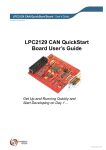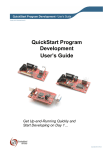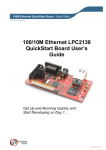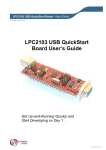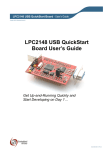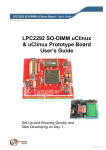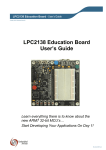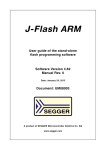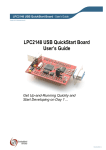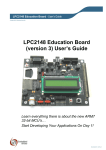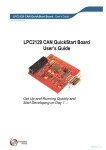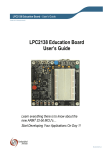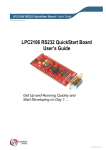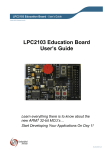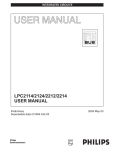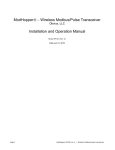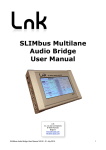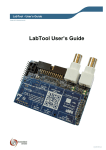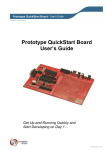Download LPC213x QuickStart Board User`s Guide
Transcript
LPC213x QuickStart Board - User’s Guide Copyright 2005 © Embedded Artists AB LPC213x QuickStart Board User’s Guide Get Up-and-Running Quickly and Start Developing on Day 1… EA2-USG-0504 v1.1 Rev D LPC213x QuickStart Board - User’s Guide Page 2 Embedded Artists AB Friisgatan 33 SE-214 21 Malmö Sweden [email protected] http://www.EmbeddedArtists.com Copyright 2005 © Embedded Artists AB. All rights reserved. No part of this publication may be reproduced, transmitted, transcribed, stored in a retrieval system, or translated into any language or computer language, in any form or by any means, electronic, mechanical, magnetic, optical, chemical, manual or otherwise, without the prior written permission of Embedded Artists AB. Disclaimer Embedded Artists AB makes no representation or warranties with respect to the contents hereof and specifically disclaim any implied warranties or merchantability or fitness for any particular purpose. Information in this publication is subject to change without notice and does not represent a commitment on the part of Embedded Artists AB. Feedback We appreciate any feedback you may have for improvements on this document. Please send your comments to [email protected]. Trademarks InfraBed and ESIC are trademarks of Embedded Artists AB. All other brand and product names mentioned herein are trademarks, services marks, registered trademarks, or registered service marks of their respective owners and should be treated as such. Copyright 2005 © Embedded Artists AB LPC213x QuickStart Board - User’s Guide Page 3 Table of Contents 1 Introduction 4 1.1 Contents 4 1.2 Features 4 1.3 Low Cost 5 1.3.1 1.4 Design and Production Services 5 Other QuickStart Boards and Kits 5 2 Board Design 6 2.1 Board Schematics 6 2.2 Mechanical Dimensions 9 2.3 Examples 10 2.3.1 JTAG 10 2.3.2 Reset 11 2.3.3 I2 C 12 2.3.4 SPI 13 2.3.5 LEDs 14 3 Getting Started 3.1 Test program 15 3.2 Program Download 15 3.2.1 Philips LPC2000 Flash Utility 16 3.2.2 LPC21ISP 17 3.3 Program Development 18 3.3.1 QuickStart Build Environment 19 3.3.2 GCC 25 3.4 Installing QuickStart Build Environment 26 4 CD-ROM and Product Registration 31 4.1 CD-ROM 31 4.2 Product Registration 31 5 Further Information Copyright 2005 © Embedded Artists AB 15 32 LPC213x QuickStart Board - User’s Guide Page 4 1 Introduction Thank you for buying Embedded Artists’ LPC213x QuickStart Board based on Philips ARM7TDMI LPC213x microcontroller. This document is a User’s Guide that describes the LPC213x QuickStart Board design along with the accompanying software and program development tools. The document contains information on how to use and integrate the board in your own designs, including electrical and mechanical information. 1.1 Contents The box received when ordering the LPC213x QuickStart Board contains the following: • The LPC2132 or LPC2138 QuickStart Board. • CD-ROM which includes additional material and programs, including complete and evaluation versions of different development environments. Observe that bulk orders (10 or 100 boards) only include one CD-ROM. In addition, the following is needed in order to start developing applications with the LPC213x QuickStart Board: • A DC power supply, 5-10 volt, capable of providing at least 150 mA (more if external circuits need power from the 3.3 volt supply). The LPC213x QuickStart Board contains reverse polarity protection, but wrong polarity is not recommended. Consult the schematic and the LD1117 datasheet for details about the voltage regulator. • A serial extension cable, DB9-male to DB9-female (DB9M-DM9F), for connecting the LPC213x QuickStart Board to a PC. • An optional JTAG interface, for program development debugging. 1.2 Features Embedded Artists’ LPC213x QuickStart Board lets you get up-and-running quickly with Philips ARM7TDMI LPC213x microcontroller. The small form factor board offers many unique features that ease your development. • Philips ARM7TDMI LPC2138 microcontroller with 512 KByte program Flash and 32 KByte SRAM, or Philips ARM7TDMI LPC2132 microcontroller with 64 KByte program Flash and 16 KByte SRAM • All LPC213x I/O pins are available on connectors • 14.7456 MHz crystal for maximum execution speed and standard serial bit rates − Phase-locked loop (PLL) multiplies frequency with four; 4 x 14.7456 MHz = 58.9825 MHz • 32.768kHz RTC crystal • ESD/EMI protected RS232 channel with DSUB-9 connector − Both UART #0 and #1 connected − Signals available on expansion connector • 2 Kbit I2C E2PROM for storing non-volatile parameters • Onboard low-dropout voltage and reset generation. Copyright 2005 © Embedded Artists AB LPC213x QuickStart Board - User’s Guide • − Generates +3.3V from a single +5V supply − +3.3V available for external circuits, up to 300 mA − Power supply: 5-10 VDC, at least 150 mA, or via USB Simple and automatic program download (ISP) via RS232 channel − • Page 5 Circuit that automatically controls the bootloader from RS232 channel Dimensions: 59 x 39.5 mm − Small form factor for easy integration − Dual 2x16 pins I/O connectors − Four layer PCB (FR-4 material) for best noise immunity 1.3 Low Cost The LPC213x QuickStart Board is very low cost and can be used for prototyping / development as well as for OEM production. Modifications for OEM production can easily be done for volumes > 1k. Contact Embedded Artists for further information about design and production services. Bulk orders (> 10 boards) can be delivered without pin rows and/or DSUB-9 connector soldered for easy integration with original equipment. 1.3.1 Design and Production Services Embedded Artists provide design services for custom designs, either completely new or modification to existing boards. Specific peripherals and/or I/O can easily be added to the different designs, for example communication interfaces, specific analogue or digital I/O, and power supplies. Embedded Artists has a broad, and long, experience in designing industrial electronics in general, and specifically with Philips LPC2xxx microcontroller family. • Prototype and low-volume production takes place in Sweden for best flexibility and short lead times. • High-volume production takes place in China for lowest possible cost. 1.4 Other QuickStart Boards and Kits Visit Embedded Artists’ home page, www.EmbeddedArtists.com, for information about other QuickStart boards / kits or contact your local distributor. Copyright 2005 © Embedded Artists AB LPC213x QuickStart Board - User’s Guide Page 6 2 Board Design This chapter contains detailed information about the electrical and mechanical design of the LPC213x QuickStart Board. A number of example circuits are also presented that will lower the threshold of start developing applications with the board. 2.1 Board Schematics Figure 1 - LPC213x QuickStart Board Schematic Copyright 2005 © Embedded Artists AB LPC213x QuickStart Board - User’s Guide Page 7 Besides the LPC213x microcontroller from Philips, the board contains a 3.3V low-dropout voltage regulator, a 2 Kbit I2C E2PROM with reset generation, and an ESD/EMI protected RS232 serial channel. Both UART channels on the processor can use the RS232 interface. Only UART #0 is however connected to the DSUB-9 connector. A red LED is connected to the reset signal and lights when reset is active, i.e., the signal is low. Power can either be supplied via the expansion connector or via the USB connector. The USB connector is only used for powering the board. The same printed circuit board is also used for the LPC214x QuickStart Board that includes the LPC214x microcontroller with on-chip USB controller (device). The components connecting the USB signals are just not mounted for the LPC213x QuickStart Board. The microcontroller crystal frequency is 14.7456 MHz. This frequency has been selected in order to allow close to maximum execution speed (4 x 14.7456 MHz = 58.9824 MHz, which is very close to the maximum frequency, 60 MHz) as well as to provide standard serial communication bit rates. The crystal frequency can be changed to any desired value for OEM orders, provided that the conditions in the LPC213x datasheet are met. Current requirements are (but consult the most current datasheet for latest details): • 1-30 MHz if the on-chip phase-locked loop (PLL) is not used, or • 10-25 MHz if the PLL is to be used. The design has direct and automatic support for program downloading (via ISP) over the RS232 serial channel. The RS232 signal DTR controls the reset signal to the LPC213x microcontroller. The RS232 signal RTS is connected to pin P0.14 in the LPC213x microcontroller. This pin is sampled after reset and determines if the internal bootloader program shall be started, or not. A low signal after reset enters the bootloader mode. The RTS/DTR signals can be disconnected from the microcontroller via two links / jumpers on the board. See Figure 2 below for details. In order from top to bottom: J7 (Reset), J6 (P0.14) Figure 2 - LPC213x QuickStart Board Jumpers Copyright 2005 © Embedded Artists AB LPC213x QuickStart Board - User’s Guide Page 8 The board interface connectors are placed in two 2x16 pin rows along the board edges. They are 1200 mil (30.48 mm) apart. Figure 3 below illustrates the two row connectors and their signals. Figure 3 - LPC213x QuickStart Board Interface Connectors Copyright 2005 © Embedded Artists AB LPC213x QuickStart Board - User’s Guide Page 9 2.2 Mechanical Dimensions Figure 4 below contains a drawing of the board that includes mechanical measures. about 6 mm J2 pin 1 J3 pin 1 59 mm J2 pin 32 J3 pin 32 about 14 mm 30.48 mm, 1200 mil 39.5 mm Figure 4 - LPC213x QuickStart Board Mechanical Dimensions Copyright 2005 © Embedded Artists AB LPC213x QuickStart Board - User’s Guide Page 10 2.3 Examples This section contains a few sample / illustrative circuit examples that will help you to quickly get up-and-running with the board interface design. Detailed information about the on-chip peripheral units can be found in the LPC213x User’s Manual. 2.3.1 JTAG The LPC213x microcontroller contains a JTAG interface that can be used for debug purposes during program development. The circuit in Figure 5 below works for many JTAG interfaces on the market, including J-link from Segger, Ulink from Keil, and Wiggler from MacRaigor. The signal RTCK on the LPC213x microcontroller is sampled during reset. Jumper J5 drives the signal low. If the signal is found low, the JTAG interface is enabled. Pin P1.26-P1.31 then changes from being general I/O pins to dedicated JTAG pins. Note that many Wiggler JTAG interfaces do not work with a processor crystal frequency above about 10 MHz. If this is the case, the crystal frequency can be changed by desoldering the 14.7456 MHz crystal and replace it with another suitable one. Figure 5 – Example JTAG Interface Copyright 2005 © Embedded Artists AB LPC213x QuickStart Board - User’s Guide 2.3.2 Page 11 Reset The on-board I2C E2PROM (CAT1025) also contains a reset generator. The reset signal will be held active (i.e., low) until the supply voltages, +3.3V, is within margins. The reset duration is typically 200 mS (consult the CAT1025 datasheet for exact details). The output reset signal is an open-collector / open-drain output. An external reset source can also control the reset generator. Figure 6 below illustrate how an external push-button can generate a reset. Observe that an external driver should be an open-collector / open-drain driver. Figure 6 – Example External Reset Push-button Copyright 2005 © Embedded Artists AB LPC213x QuickStart Board - User’s Guide 2.3.3 Page 12 I 2C The LPC213x microcontroller has an on-chip I2C communication channel (actually two, but one is used and the other is optional). The LPC213x QuickStart Board has connected a 2 Kbit E2PROM to this bus. More peripheral units are easily connected to the two-wire I2C bus. Figure 7 below illustrates how a pin expander circuit (PCF8574) can be connected to the I2C bus. Figure 7 – Example I2C Interface Observe that the pull-up resistors (which are always needed on I2C busses) are included on the LPC213x QuickStart Board., and are hence not needed on the external circuit. The pullup resistors are 3000 ohm each (see Figure 1 for complete board schematics). Copyright 2005 © Embedded Artists AB LPC213x QuickStart Board - User’s Guide 2.3.4 Page 13 SPI The LPC213x microcontroller also has two on-chip SPI serial communication channels. Figure 8 below illustrates how serial E2PROM chip, a shift register and a SD/MMC memory card are connected to the LPC213x QuickStart Board. Observe that signal SSEL (i.e., P0.7) must be high when the SPI controller (in LPC213x) operates as a master, and master operation is the normal operating mode. In Figure 8 below, signal P0.30 is used as an example to control the chip select to the serial E2PROM chip. Any other pin can be used to control chip select signals. Observe that one chip select signal is requires for each external chip that is connected to the SPI bus. Figure 8 – Example SPI Interface Copyright 2005 © Embedded Artists AB LPC213x QuickStart Board - User’s Guide 2.3.5 Page 14 LEDs The port pins of the LPC213x microcontrollers have a 4 mA driving capacity, just enough to directly drive LEDs. Figure 9 below illustrates how current is sourced from / sink to the microcontroller to drive the LEDs. The resistors limit the current to about 4 mA. The preloaded test program (described in Section 3.1 ) outputs a running-zero on all the port pins (P0.4 – P0.31, P1.16 – P1.31). A circuit like the one in Figure 9 below can be used to verify correct operation (use “active low” circuit). Figure 9 – Example LED Driving Copyright 2005 © Embedded Artists AB LPC213x QuickStart Board - User’s Guide Page 15 3 Getting Started 3.1 Test program The LPC213x QuickStart Board comes preloaded with a test program. This program can be used to verify that the board operates correctly. A circuit, like the one found in Figure 9, can be used to attach LEDs to port pins P0.4 – P0.31, P1.16 – P1.31. Pins P0.0 – P0.1 are tested via the serial channel and pins P0.2 – P0.3 are tested via the I2C bus. The test program outputs a running-zero to the port pins, meaning that one LED at a time will light (in a running-one pattern). Also, a terminal program should be attached to the RS232 DSUB-9 connector. The test program will output test information regarding the I2C and E2PROM test. Also, the UART/RS232 channel can be tested by typing characters in the terminal program. The settings for the terminal program are: 115.2 kbps, 8 data bits, no parity bits, and one stop bit (i.e., 8N1). The output from the test program will look something like in Figure 10 below. Figure 10 – Example Test Program Output 3.2 Program Download For now, it is assumed that the program to be downloaded is already developed and there exist a HEX-file to be downloaded. This HEX-file represents the binary image of the application program. Copyright 2005 © Embedded Artists AB LPC213x QuickStart Board - User’s Guide Page 16 There are basically two ways of downloading a program into the LPC2106 microcontroller: • ISP – In-System Programming The LPC2106 microcontroller provides on-chip bootloader software that allows programming of the internal flash memory over the serial channel. The bootloader is activated by pulling port pin P0.14 low during reset of the microcontroller. The LPC213x QuickStart Board contains circuits for automatically controlling pin P0.14 and the reset signal over the RS232 channel. This allows the program download to be fully automated. o Philips provides a utility program for In-System Flash (ISP) programming called LPC2000 Flash Utility. o Alternatively, there is a program called LPC21ISP that can be used. Source code is available. This program also provides a terminal functionality, which can be very helpful when developing your application program. The same serial channel that is used to download the program is typically also used for printing out information from the running program. The program immediately switch to terminal mode after program download and will hence not miss any characters sent on the serial channel directly after program start. The installation files for both programs can be found on the accompanying CDROM. • JTAG For specific information about program download (i.e., Flash programming) with a JTAG interface, consult the manual for the specific JTAG interface that is used (e.g., J-link from Segger, Ulink from Keil, or Wiggler from MacRaigor). Connect the two jumpers / links (J6 – J7) on the LPC213x QuickStart Board. This will connect the RS232 channel to the active control over pin P0.14 and the reset signal. After program download, both jumpers / links can be left connected, or removed if needed. If for example the PC end controls the RS232 signals DTR and/or RTS during normal program execution, then it might be required that jumpers / links J6 and J7 are removed after program download. 3.2.1 Philips LPC2000 Flash Utility Philips LPC2000 Flash Utility program looks like Figure 11 below. Figure 11 – Philips LPC2000 Flash Utility Screenshot Copyright 2005 © Embedded Artists AB LPC213x QuickStart Board - User’s Guide Page 17 Configure the dialog as shown above. The program will control the RS232 signals DTR and RTS if the appropriate checkbox is checked, and hence provide fully automated program download. Test connection with the LPC213x QuickStart Board by pressing the Read Device ID button. The text fields for Part ID and Boot Loader ID will then contain uploaded information from the microcontroller. Observe that the XTAL Freq. must be set to appropriate value. The default mounted crystal frequency on the LPC213x QuickStart Board is 14.7456 MHz. In this case the value 14746 shall be written in the text box. If the crystal frequency has been changed, make sure the appropriate value is set. If no connection can be established test with a low Baud Rate, for example 1200 bps. Also verify that the correct COM-port has been selected (under Connected to Port). Select the HEX file to be downloaded and then press the Upload to Flash button. The downloaded program will immediately start after the download (i.e. the Upload to Flash operation is ready) is the option Execute Code after Upload is checked. 3.2.2 LPC21ISP The LPC21ISP program is made publicly available by Martin Maurer. Source code is also available at: http://engelschall.com/~martin/lpc21xx/isp/index.html. Figure 12 below shows the command syntax for the program. Figure 12 – LPC21ISP Portable Command Line ISP Screenshot A typical program download sequence may look like in Figure 13 below. Here, the test program is downloaded. As seen, the first part is the actual program download phase. Then this is done, the program switches to being a terminal (the second part) and the messages from the test program is displayed. It also sends anything typed on the keyboard back to the LPC213x QuickStart Board. As seen the program ends when ESC is pressed. This sequence illustrates the benefits from using the program as a terminal directly after program download. No characters are missed after program start. The used command is: lpc21isp –term –control testprogram_lpc213x_qsb.hex com1 115200 14746 Copyright 2005 © Embedded Artists AB LPC213x QuickStart Board - User’s Guide Page 18 Program Download Phase Terminal Phase Figure 13 – LPC21ISP Command Line ISP Download Screenshot Another benefit with this program is that it runs under Linux. Use version 1.28, or later, of LPC21ISP.EXE since older versions must be recompiled with increased reset timeout (when the program tries to synchronize to the LPC213x QuickStart Board). The timeout should be increased to at least 350 ms. 3.3 Program Development There are many options when it comes to the actual application program development. First of all, you must select a development environment, i.e., an editor (preferably with project management capabilities), a compiler package (compiler plus linker), and a debugger. Fortunately, there are many different choices for ARM program development, each with its pros and cons. The list below is far from complete but gives a general overview. The accompanying CD-ROM (see Section 4.1 for more details) contains many of these programs / environments. • QuickStart Build Environment from Embedded Artists Embedded Artists has created a complete GCC build environment for all QuickStart boards. This will ease program development for novel users. By installing the QuickStart Build Environment you will automatically get a complete setup of the build environment. • Rowley Associates CrossWorks for ARM A complete development environment from Rowley Associates, including an editor, project manager, a complete compiler build environment, and a debugger. The version included on the CD is a 30-day fully functional evaluation version. Copyright 2005 © Embedded Artists AB LPC213x QuickStart Board - User’s Guide Page 19 • IAR Embedded Workbench A complete development environment from IAR Systems, including an editor, project manager, a complete compiler build environment, and a debugger. The version shipped with the LPC213x QuickStart Board has a 32 Kbyte program size limit, but is fully functional in all other aspects. • Keil uVision This is another complete development environment, but from Keil. It includes an editor, project manager, a complete compiler build environment, and a debugger. An evaluation version can be downloaded from Keils homepage. One version of the development environment is based on the GCC compiler (currently version 3.3.1 of GCC). • Programmers notepad This is a very good editor and project manager that is increasing in popularity. The program can easily be integrated with the GCC compiler. • Eclipse + CDT This is a very good development environment (editor and project manager) with specific support for C/C++ code development. It does not contain a compiler but can easily be connected to one, for example GCC. • GCC distribution GNUARM A complete distribution of GCC, specifically for ARM processors. Current version of GCC is 3.4.3 and the new 4.0.0, and it is constantly updated. • WinARM This is another distribution that not only contains GCC but also Programmers Notepad, LPC21ISP, a terminal program, and JTAG drivers. 3.3.1 QuickStart Build Environment The QuickStart Build Environment is a complete build environment for GCC including program downloading via ISP. The build environment is built around a bash script. This script sets up all necessary paths. When installing the QuickStart Build Environment you will automatically get shortcuts to this bash script. A practical feature is that there can be different scripts for different hardware platforms, for controlling different hardware specific details of the platforms. There can also be many different compilers (including different versions of the same compiler) without conflicting with each other. The use of the bash script is optional but is recommended for non-experienced users. A typical project has two subdirectories; build_files and startup. Figure 14 below illustrate the general structure. Figure 14 – Typical Project Directory Structure The subdirectory build_files contains a general makefile and linker script files. The subdirectory startup contains a configurable startup framework for QuickStart Board projects. The startup files form a library that is linked to the main application. The makefiles have a hierarchical structure. Each project, either an executable program file or a library, has a simple makefile that just describe the specifics of the project. This Copyright 2005 © Embedded Artists AB LPC213x QuickStart Board - User’s Guide Page 20 simple makefile includes the general makefile that is placed in the build_files subdirectory. Figure 15 below illustrates the simple makefile. The example comes from the startup library, found under the startup subdirectory. The name of the resulting library is libea_startup_thumb.a. Two C-source code files are listed: consol.c and framework.c. An assembler file called startup.S is also included in the library. ########################################################## # # General makefile for building executable programs and # libraries for Embedded Artists' QuickStart Boards. # (C) 2001-2005 Embedded Artists AB # ########################################################## # Name of target (executable program or library) NAME = libea_startup_thumb Name of resulting library. # ELF-file contains debug information, or not # (possible values for DEBUG are 0 or 1) # Extra debug flags can be specified in DBFLAGS DEBUG = 1 #DBFLAGS = # Optimization setting # (-Os for small code size, -O2 for speed) OFLAGS = -Os # Extra general flags # For example, compile for ARM / THUMB interworking (EFLAGS = -mthumb-interwork) EFLAGS = -mthumb-interwork # Program code run in ARM or THUMB mode # Can be [ARM | THUMB] CODE = ARM The files are compiled in ARM mode with THUMB interworking (see EFLAGS). # List C source files here. CSRCS = consol.c \ framework.c List all included C source files. # List assembler source files here ASRCS = startup.S List all included assembler files. # List subdirectories to recursively invoke make in SUBDIRS = # List additional libraries to link with LIBS = # Add include search paths INC = -I . Select whether an executable program file or a library shall be created. One of the lines is commented out. # Select if an executable program or a library shall be created #PROGRAM_MK = true LIBRARY_MK = true Include the general makefile here. ####################################################################### include ../build_files/general.mk ####################################################################### Figure 15 – Example QuickStart Build Environment Makefile from Startup Library As seen in Figure 15 above the makefile ends with the command: include build_files/general.mk. This is a general make file that is part of the complete build environment. This part contains all specific details of compiler and linker invocation. Also at the end, the target must be decided; either an executable program or a library. Either PROGRAM_MK or LIBRARY_MK must be set to true. Copyright 2005 © Embedded Artists AB LPC213x QuickStart Board - User’s Guide Page 21 The example makefile above is quite simple to its structure. It is possible to create more complex project structures that contain many subprojects. A typical example is to have an application project in a root folder. Under this root folder a number of subdirectories exist containing different blocks of functionality. For example, this can be a Real-Time Operating System and a TCP/IP stack. This calls for a recursive makefile structure. The makefile in the root filer will create an executable program. It also includes the makefile in each of the subdirectories. The makefiles that exist in subdirectories will create libraries. An example of a root make file is presented in Figure 16 below. ########################################################## # # General makefile for building executable programs and # libraries for Embedded Artists' QuickStart Boards. # (C) 2001-2005 Embedded Artists AB # ########################################################## # Name of target (executable program or library) NAME = testprogram_10m_eth Name of resulting program file. # Path and name of linker script file # Only needed for executable program files LD_SCRIPT = build_files/link_rom.ld Define linker script. # ELF-file contains debug information, or not # (possible values for DEBUG are 0 or 1) # Extra debug flags can be specified in DBFLAGS DEBUG = 1 #DBFLAGS = # Optimization setting # (-Os for small code size, -O2 for speed) OFLAGS = -Os # Extra general flags # For example, compile for ARM / THUMB interworking (EFLAGS = -mthumb-interwork) EFLAGS = The files are compiled in THUMB mode. # Program code run in ARM or THUMB mode # Can be [ARM | THUMB] CODE = THUMB The root folder only contains one file, the main-file. # List C source files here. CSRCS = main.c # List assembler source files here ASRCS = # List subdirectories to recursively invoke make in SUBDIRS = startup \ tcpip \ pre_emptive_os # List additional libraries to link with LIBS = startup/libea_startup_thumb.a \ tcpip/tcpip.a \ pre_emptive_os/pre_emptive_os.a # Add include search path for startup files, and INC = -I./startup Three different subdirectories that contains different blocks of functions in the final application. The three libraries that are created in the recursive invocation of make are included in the final application. other include directories Note the startup library. # Select if an executable program or a library shall be created PROGRAM_MK = true #LIBRARY_MK = true # Output format on hex file (if making a program); can be [srec | ihex] HEX_FORMAT = ihex # Program to download executable program file into microcontroller's FLASH DOWNLOAD = lpc21isp.exe Copyright 2005 © Embedded Artists AB LPC213x QuickStart Board - User’s Guide Page 22 # Configurations for download program DL_COMPORT = com1 DL_BAUDRATE = 115200 DL_CRYSTAL = 14746 ####################################################################### include build_files/general.mk ####################################################################### Figure 16 – Example Root Makefile and Recursive Invocation To build the application program, start a command prompt (the bash script), change directory to the project root, and type: make. Depending on the make file content, either an executable program or a library will be created. To also download the executable program, type: make deploy instead of just make. A final note about the make file; make clean will erase all object files and make depend will recreate dependency files (this is also always done when typing just make). Finally, make terminal will just start the terminal function in the download program (lpc21isp). The specific settings for using the ISP download program can be set with the DL_XXX variables (as seen at the end of Figure 16 above). As already mentioned, the startup files form a configurable startup framework. This is often called a Board Support package or BSP for short. It contains the very basic startup and initialization code as well as a console with printf()- and scanf()-like functionality. The BSP is very configurable and can be changed according to your specific needs. Each project can have its specific settings. The configuration file is listed in Figure 17 below, and can be found in file config.h in the startup subdirectory. /****************************************************************************** * * Copyright: * (C) 2000 - 2005 Embedded Artists AB * * Description: * Framework for ARM7 processor * *****************************************************************************/ #ifndef _config_h_ #define _config_h_ /****************************************************************************** * Defines, macros, and typedefs *****************************************************************************/ #define FOSC 14745600 /* External clock input frequency (must be between 10 MHz and 25 MHz) */ #define USE_PLL 1 /* 0 = do not use on-chip PLL, 1 = use on-chip PLL) */ /* PLL multiplication factor (1 to 32) */ /* PLL division factor (1, 2, 4, or 8) */ /* Peripheral bus speed divider (1, 2, or 4) */ #define PLL_MUL 4 #define PLL_DIV 2 #define PBSD 4 /* initialize the MAM (Memory Accelerator Module) */ #if (FOSC * PLL_MUL) < 20000000 #define MAM_TIMING 1 /* number of CCLK to read from the FLASH */ #elif (FOSC * PLL_MUL) < 40000000 #define MAM_TIMING 2 /* number of CCLK to read from the FLASH */ #else #define MAM_TIMING 3 /* number of CCLK to read from the FLASH */ #endif #define MAM_SETTING 2 /* 0=disabled, 1=partly enabled (enabled for code prefetch, but not for data), 2=fully enabled */ #define IRQ_HANDLER Copyright 2005 © Embedded Artists AB 1 /* 0 = Jump to common IRQ handler LPC213x QuickStart Board - User’s Guide Page 23 1 = Load vector directly from VIC, i.e., LDR PC,[PC,#-0xFF0] */ /*initialize the exception vector mapping */ #define MAM_MAP 1 /* 1 = exception at 0x0000 2 = exception at 0x4000 /* * CHIP SRAM SIZE SRAM START ADDRESS * LPC2104 16 * 1024 0x40000000 * LPC2105 32 * 1024 0x40000000 * LPC2106 64 * 1024 0x40000000 * LPC2114 16 * 1024 0x40000000 * LPC2119 16 * 1024 0x40000000 * LPC2124 16 * 1024 0x40000000 * LPC2129 16 * 1024 0x40000000 * LPC2194 16 * 1024 0x40000000 * LPC2131 8 * 1024 0x40000000 * LPC2132 16 * 1024 0x40000000 * LPC2134 16 * 1024 0x40000000 * LPC2136 32 * 1024 0x40000000 * LPC2138 32 * 1024 0x40000000 * LPC2210 16 * 1024 0x40000000 * LPC2214 16 * 1024 0x40000000 * LPC2220 64 * 1024 0x40000000 * LPC2290 16 * 1024 0x40000000 * LPC2292 16 * 1024 0x40000000 * LPC2294 16 * 1024 0x40000000 */ #define SRAM_SADDR 0x40000000 /* #define SRAM_SIZE (16 * 1024) /* #define SRAM_TOP (SRAM_SADDR+SRAM_SIZE) /* #define SRAM_EADDR (SRAM_SADDR+SRAM_SIZE-1) /* #define #define #define #define #define #define stackSize_SYS stackSize_SVC stackSize_UND stackSize_ABT stackSize_IRQ stackSize_FIQ #define STK_SIZE #define STK_SADDR SRAM starting address */ LPC2132 */ SRAM end address + 1 */ SRAM end address */ 600 64 64 64 600 64 (stackSize_SYS+stackSize_SVC+stackSize_UND+stackSize_ABT+ stackSize_IRQ+stackSize_FIQ) (SRAM_EADDR+1-STK_SIZE) /* Stack start address */ #define CONSOL_UART #define CONSOL_BITRATE 0 115200 #define USE_NEWLIB 0 #define CONSOLE_API_PRINTF 1 #define CONSOLE_API_SCANF 0 #endif vectors are in FLASH 0000, vectors are in SRAM 0000 */ /* 0 = do not use newlib (= save about 22k FLASH), 1 = use newlib = full implementation of printf(), scanf(), and malloc() */ /* 0 = printf() = sendString, 1 = simple, own implementation of printf() */ /* 0 = none, 1 = simple, own implementation of scanf() */ /* _config_h_ */ Figure 17 – Board Support Package (BSP) Configuration File There are three versions of the consol in order to best fit different situations: • A very simple version that basically only supports printing strings (without any formatting parts) and printing numbers (decimal or hexadecimal). • A simple printf() implementation that supports the simplest formatting tags. The implementation has been designed for lest possible stack usage (about 40 bytes). Copyright 2005 © Embedded Artists AB LPC213x QuickStart Board - User’s Guide • Page 24 A full ANSI printf() implementation from newlib (part of the compiler environment that comes with GNUARM). This routine requires about 600 bytes of stack space and should normally not be used in resource constraint systems. The code size for the first two alternatives is minimal (about 2k in program size for the entire framework). When using printf() from newlib, the code size is about 30 k for the entire framework (including a large part of the newlib library). Just edit the configuration file above and recompile your project. The recursive nature of the makefiles will make sure that the startup library is recompiled and linked with the final executable program. You can find an example project under the QuickStart Build Environment installation. See Figure 18 below for the path. It is typically: c:/program/InfraBed/evboards/LPC2xxx-gcc-newlib-vX_X_X_X. The beginning of the path can be specific for your installation and the ending of the path is specific for the version of the build environment. The figure below illustrates version 2_0_0_0. Figure 18 – Sample Project Files under QuickStart Build Environment Installation The startup framework (BSP) is very simple and can best be understood by studying the source code files. If using the console functionality (printf()- and scanf()-like functions) observe that the function eaInit() must be called before printf() and the console can be used. The following code segment illustrates this. #include <ea_init.h> ... ... int main(void) { eaInit(); //Now, the console/printf can be used ... } Also observe that whenever the BSP printf() should be used, the following include file must be included into the source code file. #include <printf_P.h> As a summary; Embedded Artists’ QuickStart Build Environment is comprised of: • A make build environment, controlled by bash script. A program or library build is started via the command: make. • A program download feature, by using the LPC21ISP program. A program build and download is started via the command: make deploy. • A Board Support Package (BSP) with startup code and console functions (i.e., printf() and scanf()-like functionality). Copyright 2005 © Embedded Artists AB LPC213x QuickStart Board - User’s Guide 3.3.2 Page 25 GCC This will be very similar to the QuickStart Build Environment example, except that you will have to set up all paths manually and create your own startup files. The make files will also be a bit more complex. An example makefile is presented in Figure 19 below. More complex examples than the makefile below also exist. # # Example makefile that creates a program called ‘test’, containing the # C-source code files: main.c, eeprom.c, and i2c.c plus the assembler # file startup.S # LIBS DEBUG CFLAGS INCLUDE ARMCC OBJS LDFLAGS = = = = = = = -g -Wall -nostartfiles -mthumb-interwork –mthumb -Iinc/ -Iinc/specific/ #specify include paths here arm-elf-gcc main.o eeprom.o i2c.o startup.o -Wl,-Trom.ld #this file controls the linker all: test.hex test: $(OBJS) arm-elf-gcc $(CFLAGS) $(LDFLAGS) $(OBJS) $(LIBS) -o test.elf %.o: %.c arm-elf-gcc -c $(INCLUDE) $(CFLAGS) $< %.o: %.S arm-elf-gcc -c $(INCLUDE) $(CFLAGS) $< %.o: %.c arm-elf-gcc -c $(INCLUDE) $(CFLAGS) $< %.hex: % arm-elf-objcopy -O ihex $<.elf $@ clean: rm -f *.o test.elf test.hex Figure 19 – Example GCC Makefile Copyright 2005 © Embedded Artists AB LPC213x QuickStart Board - User’s Guide Page 26 3.4 Installing QuickStart Build Environment This section describes the necessary steps of program installation that is needed to get the QuickStart Build Environment ready for your use. • Copyright 2005 © Embedded Artists AB Start with installing the GNUARM distribution that is included in the CD-ROM. The current version of the file is called: bu-2.15_gcc-3.4.3-c-c++-java_nl1.12.0_gi-6.1.exe. There is also a newer, but less well tested, version (based on GCC v4.0.0). Only use this newer version if you are an experienced user. The installation is very simple and straightforward. It’s just following the default installation steps as illustrated in the pictures below: LPC213x QuickStart Board - User’s Guide Page 27 Use the default installation directory If you want to save space on your harddisk, you can deseclect the Big Endian component. Copyright 2005 © Embedded Artists AB LPC213x QuickStart Board - User’s Guide Page 28 Install the Cygwin DLLs. Copyright 2005 © Embedded Artists AB LPC213x QuickStart Board - User’s Guide • Copyright 2005 © Embedded Artists AB Page 29 Now install the LPC2xxx-gcc-newlib_vX_X_X_X QuickStart Build Environment (vX_X_X_X is the current version of the file). The installation is also in this case very simple and straightforward. Just follow the default installation steps. LPC213x QuickStart Board - User’s Guide Page 30 Use the default installation directory Observe that if the compiler is not installed on the default location (c:/Program/GNUARM/) the new path must be set in the files build.sh and build_environment.sh. Both files can be found in: C:\Program\InfraBed\evboards\LPC2xxx-gcc-newlib-vX_X_X_X\bin). It is the variable COMPILERDIR2 that must be set (can be found on line 13 in both files). The compiler path must be to the GNUARM/bin directory. Observe that the path above must contain the correct version number instead of …vX_X_X_X\bin. It may for example be: …v2_1_0_0\bin. Copyright 2005 © Embedded Artists AB LPC213x QuickStart Board - User’s Guide Page 31 4 CD-ROM and Product Registration The accompanying CD-ROM contains a lot of information and programs that will QuickStart your program development! Observe that there may be newer versions of different documents and programs available than the ones on the CD-ROM. See Section 4.2 for information about the product registration process, which allows you to always have access to the latest versions. 4.1 CD-ROM The following is included on the CD-ROM: • The preloaded test program as a HEX-file. • The two different ISP download programs. • Datasheets of all circuits on the LPC213x QuickStart Board. • QuickStart Build Environment from Embedded Artists, which contains a complete setup of a build environment for GCC. • A complete development environment: Rowley Associates CrossWorks for ARM, 30-day evaluation version. • A complete development environment: IAR Embedded Workbench for ARM, Kickstart Edition with 32 Kbyte program size limit. • Another complete development environment: GCC, GNUARM distribution, including compiler, linker, make, and debugger. • The program Programmers Notepad, which is a very good program development editor and project manager. • The Eclipse development environment including the CDT (C/C++ Development Tools) project. 4.2 Product Registration By registering as a customer of Embedded Artists you will get access to more valuable material that will get you up-and-running instantly: • Access to a Real-Time Operating System (RTOS), in the form of a library that can be used for non-commercial applications. • Access to a number of sample applications that demonstrated different (peripheral) functions in the LPC213x processor. • Access to the latest versions of all information and programs on the CD-ROM. Registering is easy and done quickly. 1) Go to http://www.EmbeddedArtists.com, select Support and then Register. 2) Type in the products serial number (can be found on the LPC213x QuickStart Board or on the package carrying the board) along with your personal information. Copyright 2005 © Embedded Artists AB LPC213x QuickStart Board - User’s Guide Page 32 5 Further Information The LPC213x microcontroller is a complex circuit and there exist a number of other documents with a lot more information. The following documents are recommended as a complement to this document. [1] Philips LPC213x Datasheet http://www.semiconductors.philips.com/acrobat/datasheets/ LPC2131_32_34_36_38_2.pdf [2] Philips LPC213x User’s Manual http://www.semiconductors.philips.com/acrobat/usermanuals/ UM10120_1.pdf [3] Philips LPC2132/38 Errata Sheet http://www.semiconductors.philips.com/acrobat/erratasheets/2132.pdf http://www.semiconductors.philips.com/acrobat/erratasheets/2138.pdf [4] ARM7TDMI Technical Reference Manual. Document identity: DDI0029G http://www.arm.com/pdfs/DDI0029G_7TDMI_R3_trm.pdf [5] ARM Architecture Reference Manual. Document identity: DDI0100E Book, Second Edition, edited by David Seal, Addison-Wesley: ISBN 0-201-73719-1 Also available in PDF form on the ARM Technical Publications CD [6] ARM System Developer’s Guide – Designing and Optimizing System Software, by A.N. Sloss, D Symes, C. Wright. Elsevier: ISBN 1-55860-874-5 [7] Embedded System Design on a Shoestring, by Lewin Edwards. Newnes: ISBN 0750676094. [8] GNU Manuals http://www.gnu.org/manual/ [9] GNU ARM tool chain for Cygwin http://www.gnuarm.com [10] An Introduction to the GNU Compiler and Linker, by Bill Gatliff http://www.billgatliff.com [11] LPC2000 Yahoo Group. A discussion forum dedicated entirely to the Philips LPC2xxx series of microcontrollers. http://groups.yahoo.com/group/lpc2000/ [12] The Insider’s Guide to the Philips ARM7-Based Microcontrollers, by Trevor Martin. http://www.hitex.co.uk/arm/lpc2000book/index.html Especially observe document [3]. There exist a number of bugs in the processor that is important to be aware of. Observe that there can be newer versions of the documents than the ones linked to here. Always check for the latest information / version. Datasheets for all circuits on the LPC213x QuickStart Board are included on the accompanying CD-ROM. Copyright 2005 © Embedded Artists AB
































